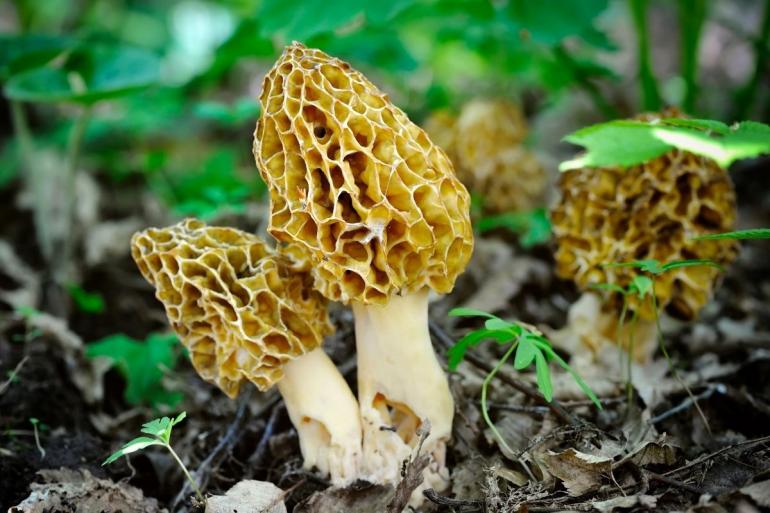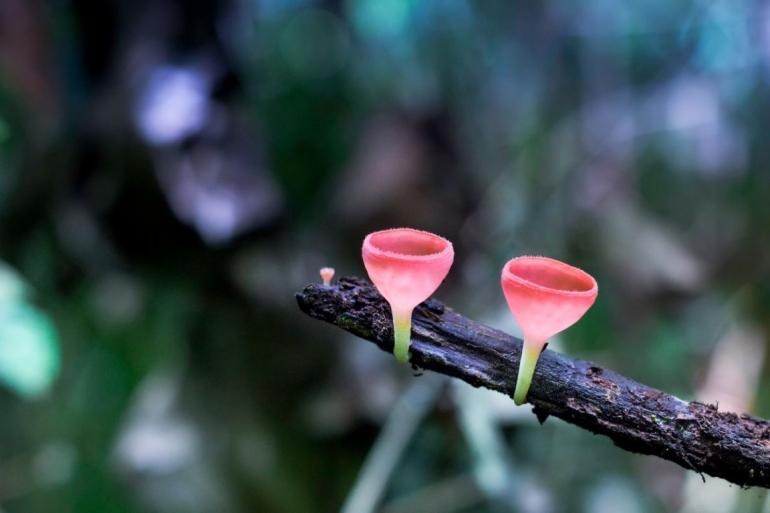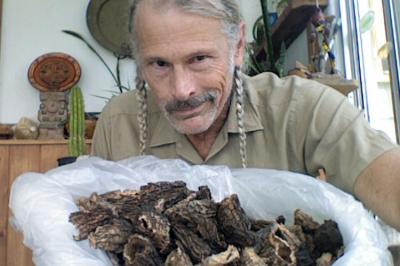After the Burns: Hunting for Mushrooms

"The way I see it, the mother lode is right here."
I pointed at the map, and looked up at a raging confluence of rivers. The spot on the map where my finger rested corresponded to a patch of burned forest on the wrong side of two rivers in full spring flood.
"In the summer you can wade across that creek, in some places," Egan offered.
"Not planning to wait that long, myself." I replied.
But it is obvious why that stretch of prime habitat remains untouched. It is three miles up the creek to the first possible crossing, where a fallen tree spans the churning water, and then three miles back down to this spot. There are plenty of morels closer to the trailhead than that. And the wall of water surging between us and the opposite bank really is a problem.
We had just spent the weekend picking this burn, probing the blackened canyons and crawling over a tumble of downed timber like ants on a pile of toasted toothpicks. We did fine, but you can't go pick those mushrooms again, so we were looking for the next major spot. Access was the issue, and all this water was the reason.
Morel mushrooms have a world-wide reputation among chefs and foodies that spans cultures and goes back centuries. They are hunted on every continent save Antarctica and have names and aliases without end in every form of human speech. I have personally hunted morels widely in North and South America and Asia and have spent the last 30 morel seasons camped in a burn zone somewhere. I suppose you could call me obsessed, but that makes it sound like a problem. The problem is that morel season only lasts a few weeks every year. That's the problem.

A lot of people see it my way. Enough to support a worldwide market in morels that moves millions of dollars of this exquisite delicacy from forest to fork, from Phillipsburg to Paris, every year. So into the burn we go, (hi ho hi ho...) but only after hour upon hour spent sifting through fire reports, watching weather patterns, and plenty of "ground truthing," or scouting, lots of hours scooting my little car over sketchy mountain roads, and a time or two digging out of late season snowbanks. The thawing snow feeds an entire ecosystem as it melts, and the ecology of snowmelt mushrooms has been cataloged and described by mycologists for a century. Whether the surrounding forest is green or burned determines which sorts of fungi will thrive in the brief moist season. About a quarter of all the Ascomycetes, or cup fungi species, fruit exclusively after a burn event. Dozens of these species make tiny orange cup-shaped fruiting bodies, and these are collectively dismissed as "orange mold" by the casual observer.
But taken together, the collection of mushroom species that arise from the ashes of a forest fire do so in a regular sequence, so much so that I can judge the age of a burn zone pretty accurately by what species of mushrooms have appeared. The spring following a burn, morels and orange mold share the burn with fire-following fairy cups (Geopyxis carbonaria gp) a carbon-loving Psathyrella, and a handful of mushrooms that appear nowhere else. After a year, when the fireweed has sprouted, Pholiota highlandensis tells me it is too late to look here for morels. Another year or so, and Rhizina sp. may form dark undulating fruits over the burnt soil. Inocybe sp. poke up their pointy heads where the new lodgepole seedlings are taking hold.
And so it goes, more and different mushrooms appearing as the succession continues, until after 80 years or so you can find chanterelles there once again...
What is a mushroom, anyway? Morels and other mushrooms are the reproductive structures of certain types of fungi. Fungi are a life form separate from plants and animals that exist as a collection of thread-like hyphae, or mycelia. These mycelia pack forest soils with miles of microscopic fibers in every handful, and they seasonally migrate up and down in soils, following moisture from the soil surface to many meters below the surface. Not all fungi produce mushrooms, indeed most do not produce reproductive structures big enough to attract our human notice. Yet these microscopic fungal fibers shape the nature of soils and are a primary source of amino acids in every known ecosystem. Fungal hyphae push through the soil or woody substrate, secreting enzymes from their growing tip that digest the organic matter outside the hyphae and then sucking these nutrients in through their cell walls to feed.
Meanwhile back at the river, we packed up the camp and got ready for a unique approach to the patch. Although we were later to successfully navigate to and from the patch with canoes, it required super sharp reflexes, split-second timing to disembark and secure the canoe, and a no-mistakes performance on the fast-moving water over a rock-strewn bed. In today's conditions there was no chance a canoe would work. The water was just too high. Even those of us lacking a sense of fear could tell this was a battle best left unpicked.

But Egan had friends. Friends with boats, the best kind. And pontoon boats at that. With careful seating, we could get on board suspended inches above the water. So, dry, essentially— not high and dry—but dry. And floating downriver fast. Rocks and sweeps in the river come up fast as we zipped downriver, scooting like water skippers towards the opposite bank. We were swept a quarter mile downriver as we approached the steep shore.
Since 1991, the Western Montana Mycological Association has offered workshops and forays focused on mushrooms— not all of them as exciting as this one—every spring and fall season. These forays are always campouts, and attract dozens of dedicated mushroom hunters from all over the state. We have never been skunked on our annual morel hunt. In fact, I don't believe even a single participant has been skunked, although some may have aroma issues regardless. An average WMMA spring foray nets dozens of species of mushrooms, and a BioBlitz at Glacier National Park turned out 60 humans and over 240 fungal participants in the spring of 2017. Even so, I reckon there are dozens of undescribed species still waiting, since we could only sample a limited number of locations. Globally researchers estimate 10 species of fungi for every species of plant.
In the last 30 years or so, Montanans have come to better appreciate the importance of fungi in our cold and dry climate. Worldwide, our northern coniferous forests are some of the most important for, and efficient at, sequestering carbon. This is due to the killer efficiency that our local mycorrhizal mushrooms display at pulling nitrogen and phosphorus out of forest detritus, leaving behind reduced carbon. This is mostly in the form of Brown Cuboidal Rot (BCR) the reddish-brown lignin left behind after fungi have digested the cellulose fibers out of decaying wood. BCR is key to the survival of our montane ecosystems, where the soils have evolved from two basic components: mineral (rock) and organic (BCR) material. Rock, as you may have noticed, does not absorb water. BCR on the other hand holds upwards of five times its weight in water. Guess where 85% of the available water is found when the trees go looking? It is a trick question; you know the answer is mushrooms. Fungal hyphae or mycelia penetrate these masses of brown cuboidal rot and then transport this water to the tree roots, in exchange for photosynthetic treats. Mycorrhizae are the swellings on the root tips of every conifer, and these organs serve as the water and nutrient exchange ports between tree and fungus.
But I had no time to think about this as our pontoon boat was ricocheting off the rocky shore, as the oarsman pulled mightily against the current to slow our craft, and I grabbed the bow line and jumped on the narrow brushy rocky beach and braced myself on a dogwood bush. The boat swung around and scooted ashore. We hefted it out of the water and up on the bank and surveyed the burn zone before us.
Yup, okay, yup, this was where we wanted to be... morels showing themselves at every step...!
Ah, the joyful tedium of harvesting. We all got 10 or 15 pounds.
Getting back across the river was doubly exciting, each of us anxious about spilling our hard-won bounty before stepping on solid ground again.


Larry Evans, named "the Indiana Jones of mushrooms" by a diplomat in the Russian Far East during the 1990s, has spent years researching mushrooms and nontimber forest products in Asia and the Americas. He is a certified mushroom vendor and taught mycology at UM and the Glacier Institute for decades. He is a founder of the Western Montana Mycological Assn. (fungaljungal.org) and has recorded 2 CDs of mushroom music, Fungal Boogie (2003) and Fungal Boogieman (2007) and appeared in Ron Mann's comedocumentary Know Your Mushrooms (2009).












- Reply
Permalink